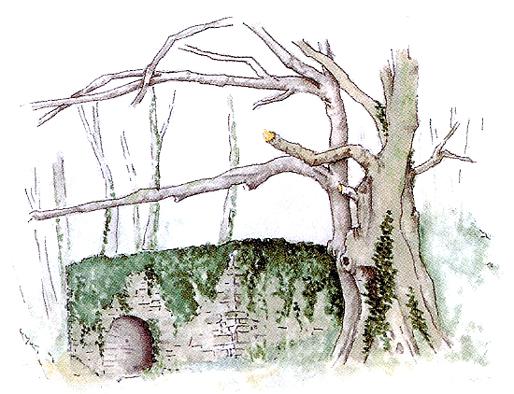The Limekiln near the Gorlofen to Brixton Footpath
|
This kiln is in a fairly ruinous state but the main features are clearly discernible, namely the cone-shaped interior (the 'pot') and the hearth opening (draw-hole) at the base. Unfortunately, it has been used as a dumping site for corrugated iron sheets. It is also typically sited into a hillside where the narrow limestone outcrop (which continues westwards to just beyond Venn Quarry) could be quarried and fed straight into the top of the kiln. The kilns at Kitley Caves are similar. Another common site in Devon was on estuaries so that limestone and fuel could be brought in by boat; Wonwell on the Erme estuary has good examples. Others were located on harboursides, as at Clovelly. The kiln would be charged with alternate layers of limestone and coal or wood and then fired from a recessed opening at the base. The burn would last for several days, and then the powdered quicklime could be shovelled out at the base into waiting carts. Farmers used most of the lime, and there are stories of carts being set on fire by farmers too eager to load up with still-hot lime! |
There was also a demand for lime wash for house walls and mortar. It was heavy, dirty and, at times, dangerous work for all involved.
Lime burning was a widespread and important part of the rural economy. There are records of lime burning at West Sherford in the reign of Henry VIII. The kiln near Gorlofen was probably a small-scale operation intended to supply farmers in the immediate surroundings, and used intermittently. (There is no mention of lime burning as an occupation in Brixton in old directories.) It possibly dates from the end of the 18th century, a time of major agricultural improvements. 'The general alertness for agricultural improvements has lately stimulated the farmers {of the Parish of Ashreigny} to search for limestone.' (Richard Polwhele, The History of Devonshire, vol.1, 1797.)
Lime burning on this scale declined quite rapidly in the latter part of the 19 th century with improved transport and the replacement of quicklime with crushed limestone, which was both cheaper and easier to handle.

